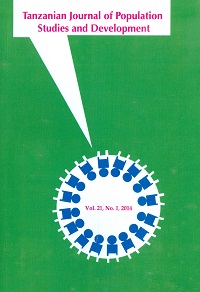What Determines Labour Force Participation of Tanzanian Women?
Abstract
This paper estimates the determinants of labour force participation of Tanzanian women. It employs data from the 2006 Integrated Labour Force Survey. The key determinants found are: children (they both reduce and increase the odds of participation); age (it increases the odds of participation); marital status of women (it decreases and increases the odds of participation); education level (it increases the odds of participation); the education level of a woman ' s spouse (it increases the odds of participation); the employment status of a woman ' s spouse (it increases the odds of participation if spouses are in self-employment, but it reduces the odds of participation for other statuses); household income (higher incomes increase the odds of participation, but it reduces the odds of participation for women in lower incomes); and location (it increases the odds of participation for women living in urban areas but reduces the odds of participation for rural women). These findings have implications that can help to increase the participation of women in the labour force. Firstly, education (both for women and their spouses) remains a sure way of increasing the participation of women in the labour market by imparting and enhancing skills for more effective participation in the labour market. Secondly, child-minding programmes for women who are in their childbearing years are important so that having children does not constrain women ' s participation in the labour force.
References
Aaronson, D., L. Hu, A. Seifoddini & D. G. Sullivan. "Declining labor force participation and its implications for unemployment and employment growth. Economic Perspectives 4Q/2014, Federal Reserve Bank of Chicago.
Ackah C., C. Ahiadeke & A. P. Fenny. 2009. Determinants of Female Labour Force Participation in Ghana. Institute of Statistical, Social and Economic Research, University of Ghana.
African Development Bank (AFDB). 2009. Assessing Progress in Africa toward the Millennium Development Goals: MDG Report 2009. Abidjan.
Assens, J. & K. Jensen. 2003. Profile of the Labour Market and Trade Unions in Tanzania. Danish Trade Union and Council for International Development Cooperation, (LO/FTF Council).
Balleer, A., R. Gomez-Savador & J. Turunen. 2009. Labour Force Participation in the Euro Area: A Cohort Based Analysis. Working Paper Series No. 1049, European Central Bank.
Berndt, E.R. 1991. The Practice of Econometrics: Classic and Contemporary, Addison-Wesley Publishing Company.
Bhalla S.S. & R. Kaur. 2011. Labour Force Participation of Women in India: Some Facts, Some Queries. Asia Research Centre Working Paper 40, Asia Research Centre, London School of Economics & Political Science.
Bover, O. & M. Arellano. 1995. Female Labour Force Participation in the 1980s: The Case of Spain. Investigaciones Economicas, XIX(2): 171 €“194.
Chamlou, N., S. Muzi & H. Ahmed. 2011. Understanding the Determinants of Female Labour Force Participation in the Middle East and North Africa Region: The Role of Education and Social Norms in Amman. AlmaLaurea Working Papers, No. 31.
Fadayomi, T.O. & I. O. Olurinola. 2014. Determinants of Labour Force Participation in Nigeria: The Influence of Household Structure. Journal of Economics and Development Studies, 2(2): 169 €“190. American Research Institute for Policy Development.
Hafeez, A. & E. Ahmad. 2002. Factors Determining the Labour Force Participation Decision of Educated Married Women in a District of Punjab. Pakistan Economic and Social Review, XL(1): 75 €“88.
Heckman, J.J. & M.R. Killingsworth. 1986. Female Labour Supply: A Survey. In O. Ashenfelter & R. Layard (eds.). Handbook of Labour Economics, Volume I. Elsevier Science Publisher BV.
Ince, M. & M. H. Demir. 2006. The Determinants of Female Labour Force: Empirical Evidence from Turkey. Eskisehir Osmangazi Ãœniversitesi Iibf Dergisi, Nisan, 1(1): 71 €“90.
Jaumotte, F. 2003. Female Labour Force Participation: Past Trends and Main Determinants in OECD Countries. OECD Economics Department Working Papers, No. 376, OECD Publishing.
Kabeer, N. & S. Mahmud. 2004. Rags, Riches and Women Workers: Export-oriented Garment Manufacturing in Bangladesh. In Chains of Fortune: Linking Women Producers and Workers with Global Markets. London: Commonwealth Secretariat.


